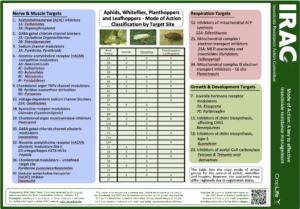White-backed planthopper
Sogatella furciferaS. furcifera is a migratory insect that is one of the most important pest species on rice in many Asian countries but problematic pest throughout the main rice-growing areas of Oceania and Australia too.
The nymphs and adults of S. furcifera are phloem feeders. They prefer young plants, but all growth stages can be attacked. Plant injury results mainly from the loss of water and nutrients with the extracted sap. In addition to causing direct damage, S. furcifera is a vector of several rice pathogens, particularly the Southern rice black-streaked dwarf virus, which causes large yield losses.
After a pre-oviposition period of 3-8 days, the female lays 100-350 eggs into stems or along the midribs of leaves may have up to 5 generations per season. Adults are very active and instantly jump away
White-backed planthopper resistance profile
Resistance of S. furcifera to the pesticides used for its control has gradually increased since the 1980s. Organophosphates, carbamates, pyrethroids, buprofezin, pymetrozin and neonicotinoid insecticides are all impacted by now in the most intensive South-East Asian regions.
| Species | Distribution | Chemical class | Mechanisms |
|---|---|---|---|
| Sogatella furcifera | South-East Asia | Buprofezin (16) | |
| Sogatella furcifera | South-East Asia | Pyrethroids-Pyrethrins (3A) | Elevated glutathione S-transferases |
| Sogatella furcifera | South-East Asia | Organophosphates (1B) | Elevated glutathione S-transferases |
| Sogatella furcifera | South-East Asia | Carbamates (1A) | Elevated glutathione S-transferases |
| Sogatella furcifera | South-East Asia | Phenylpyrazoles (Fiproles) (2B) | |
| Sogatella furcifera | South-East Asia | Neonicotinoids (4A) | |
| Sogatella furcifera | South-East Asia | Pymetrozine (9B) |

